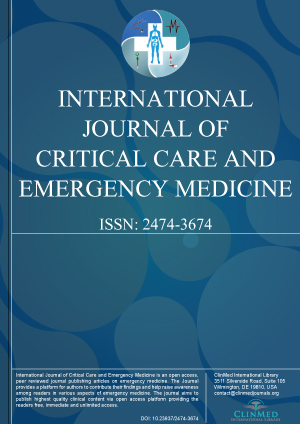Open Access DOI:10.23937/2474-3674/1510015
Addressing Moral Distress in Critical Care Nurses: A Pilot Study
Rose Allen and Eve Butler
Article Type: Research Article | First Published: May 03, 2016
Background: Moral distress can affect critical care nurses caring for complex patients. It can result in job dissatisfaction, loss of capacity for caring, and nurse turnover, resulting in a negative impact on quality care. Aim: This study purpose was to determine how moral distress impacts critical care nurses (adult and pediatric) and to implement improvement strategies to reduce moral distress, improve job satisfaction, and retention. Theoretical framework: Nathaniel's Theory of Moral Reckonin...
Open Access DOI:10.23937/2474-3674/1510014
Use of Transthoracic Impedance Data to Evaluate Intra-arrest Chest Compression Quality
Jonathan W Kamrud, Lori L Boland, Carol L Frazee, Tyler G Kinzy, Paul A Satterlee and Charles J Lick
Article Type: Research Article | First Published: May 02, 2016
Mechanical compression devices purportedly improve the quality of chest compressions by minimizing interruptions and maintaining optimal rate and depth, but this claim has not been objectively substantiated using transthoracic impedance (TTI) recordings from applied setting cardiac arrests. In this study, we use TTI data to compare chest compression quality metrics from the manual versus mechanical compression phases of out-of-hospital cardiac arrests (OHCA) treated with the LUCAS™ mechanical co...
Open Access DOI:10.23937/2474-3674/1510013
Use of Steroid for Extubation Failure due to Stridor in Surgical Intensive Care Patients
Nissar Shaikh, Tasneem Mehesry, Gulzar Hussain, Arshad Chanda, Ali Belkhair, Syed Sheikh, Faisal Malmstrom and Marcus AE
Article Type: Research Article | First Published: April 08, 2016
Extubation failure increases morbidity and mortality in intensive care. Laryngeal edema which developed post extubation is one of the major risk factor for extubation failure. Post extubation laryngeal edema occurs in up to 37% of the extubations. Steroids are commonly used pre extubation to prevent development of laryngeal edema. Aim of this study was to find whether steroids can prevent post extubation laryngeal edema and types of patients who frequently fails extubation....
Open Access DOI:10.23937/2474-3674/1510012
Almost Total Airway Obstruction Due to Unidentified Massive Hemoptysis under Extracorporeal Membrane Oxygenation
Satoshi Kazuma, Yoshiki Masuda, Hiroomi Tatsumi, Kanako Takahashi, Shinichiro Yoshida, Maiko Honma, Hitoshi Imaizumi and Michiaki Yamakage
Article Type: Case Report | First Published: February 26, 2016
A 54-year-old female weighing 62 kg had hemoptysis with an unidentified focus 4 months before and had been followed in the Department of Respiratory Medicine. Angiographic embolization was performed for a right bronchial artery ramification suspected of being the bleeding focus by bronchofiberscopy, but there were few effects. Right middle lobectomy was performed to control the persistent hemoptysis, and tracheal extubation was performed on the second day of illness. Sustained hemoptysis develop...
Open Access DOI:10.23937/2474-3674/1510011
Inter-hospital Critical Care Transport: Implementation of a Novel Policy and Review of the Literature
Andrea M Pakula, Jannet Gannon, Lisa Mundy, Kathleen Berns, Anita Stoltenberg and Beth A Ballinger
Article Type: Literature Review | First Published: January 30, 2016
The decision to transport a critically ill patient is based on the need for diagnostic or therapeutic procedures that are not available within the intensive care unit. Most commonly this type of transport is within the home facility and is for procedures such as imaging or for operative intervention. Theoretically, intra-hospital transfers are safer than the transfers to another institution, as transfers outside of the home facility tend to require the coordination of extensive cardio-pulmonary ...
Open Access DOI:10.23937/2474-3674/1510010
Inadvertent Late Migration of Jugular Catheter and Bilateral Pleural Effusion and Pneumomediastinum
Yiheng Wang, Lixian He, Xiaoling Hu, Zhigang Zhou, Hong Zhou
Article Type: Case Report | First Published: January 30, 2016
The authors report an inadvertent late migration of right jugular catheter and the unexpected complications. Postoperative computed tomography reveals bilateral pleural effusion and pneumomediastinum. We speculate that the migration during the maintenance or multiple attempts of placing a guidewire damaged the wall of right brachiocephalic vein or superior vena cava, and punctured through right pleura and anterior mediastinal leading into the complications....

